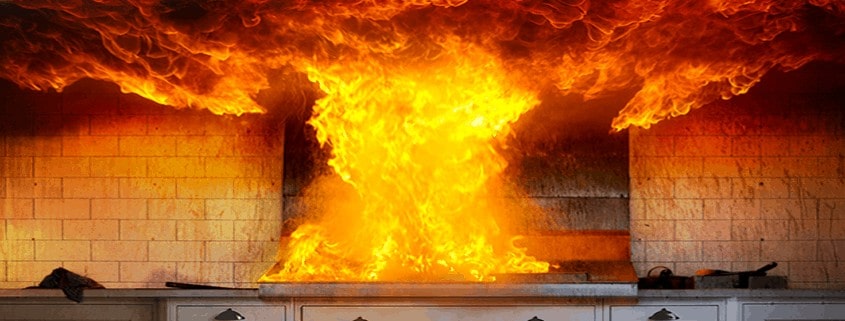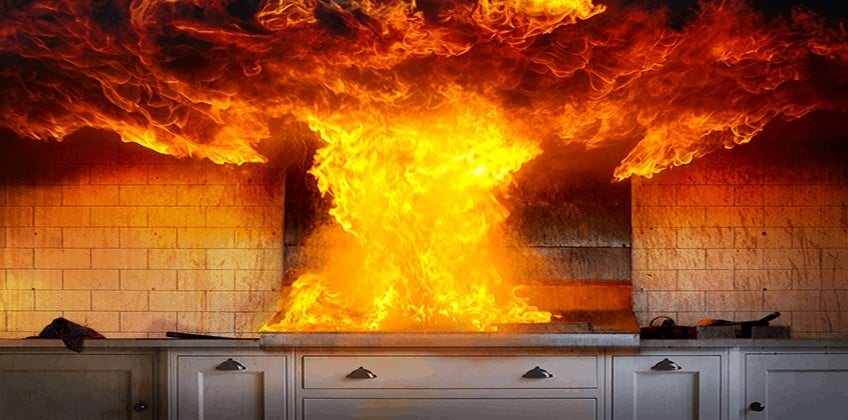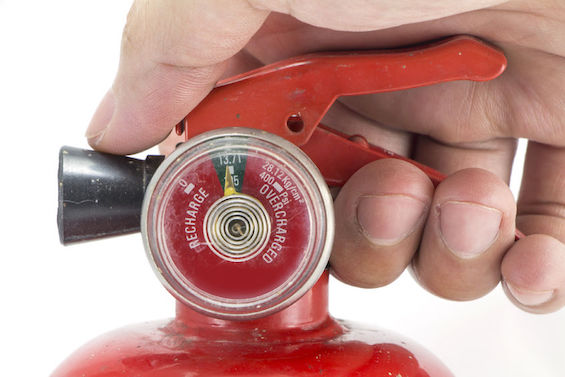The One Simple Thing You Must Have in Your Home
My heart was pounding, the smoke alarm was screaming and I was in full-on panic mode. Flames were reaching toward the upper kitchen cabinets. It happened so fast! I didn’t have time to run to the pantry to search for baking soda.
I had a rip-roaring fire on my hands and I was in slow motion thinking about how sad it would be to be homeless for Christmas.
I’d run to the garage to let my husband know I was making lunch—grilled cheese sandwiches. I got distracted. When I returned, small flames were shooting from the sizzling hot skillet. My quick-thinking told me to smother a grease fire, so I grabbed a pot lid to do that, but it wasn’t airtight and soon the flames were double the size and spreading.
That’s when I locked eyeballs with the fire extinguisher that had been sitting on the counter for so long it blended into the décor.
I’d never engaged a fire extinguisher before. I read the instructions once but that’s about it. Not knowing what to expect, I grabbed that thing, jerked out the red plastic ring (it came out easily), pointed the nozzle, and pulled the trigger. It put out the fire with one mighty blast of fine yellow powder so strong and powerful it nearly knocked me off my feet.
Shocking stats
My experience not only woke me up, but it also sent me into research mode. What I learned is sobering, if not shocking: Each year, fire kills more Americans than all other natural disasters combined. Eighty percent of all fire deaths occur in residences. Where do those residential fires start? In the kitchen!
First call 911
As grateful as I am, I did not do everything by the book. A fire extinguisher is no substitute for the fire department. One-third of all people injured by fire are hurt while trying to control it. Fire safety professionals tell us to call 911 first. Then, use the extinguisher.
Be sure that you can get out fast and that the fire is small and not spreading. Grab that extinguisher, stand back six feet and engage!
If the fire does not go out quickly, close the door to the room, get everyone out of the house, and exit the premises promptly. Meet the fire department in front and direct them to the location of the fire.
How Many Fire Extinguishers Should I Have?
You should have, at minimum, one fire extinguisher for every 600 to 700 sq. ft. per floor of your home. However, if you do have only one extinguisher, it should be in a centrally located area, mounted off the ground, and in an easy-to-see place so that in the event of a fire, no one wastes time searching for it.
However, it’s recommended that you have a fire extinguisher handy for any location that’s a potential fire hazard. This includes near chimneys, fireplaces, a furnace, the stove, the dryer, or other potentially risky areas.
Memorize: P-A-S-S
Attack the fire using the PASS method:
Pull the pin
By pulling the pin, the operating lever should unlock and allow you to discharge the extinguisher.
Aim low
Point the extinguisher hose or nozzle at the base of the fire.
Squeeze the lever
This should discharge the extinguishing agent. Some extinguishers may have a button or other means of activation. Know your extinguisher!
Sweep from side to side
While you are aiming at the base of the fire, you should sweep back and forth until the fire is extinguished. If the fire re-ignites, repeat the process.
If the fire does not go out quickly, close the door to the room, get everyone out of the house and exit the premises promptly. Meet the fire department in front and direct them to the location of the fire.
Best Inexpensive
Amerex Fire Extinguisher
This chemical extinguisher, while not the cheapest, is the best you can get the home and garage. It will work on all kinds of fires—trash, wood, and paper; flammable liquids; and electrical blazes. It weighs 10 lbs. and holds 5 lbs. of powder. That’s not super lightweight but very manageable. And it is rechargeable. For the peace of mind this extinguisher offers and the life of its charge, it get our Best Inexpensive designation. It’s the best money you will ever spend when it comes to emergency preparedness. You should consider one in the house which hangs in full view right inside the entrance. Another in the garage is a very good idea.
Easy to Use
First Alert Tundra
This option is an easier-to-use than the traditional canister extinguisher. Even though smaller and appearing to be more humble than say the Amerex above, this aerosol can option is capable of putting out all major kinds of small fires, including grease and electrical fires. Super easy to use! Having one of these in every room of your house would be a very good idea. Good for seniors with arthritic or other health limitations. Not rechargeable.
Specific for Kitchens
First Alert Kitchen
This First Alert Kitchen extinguisher delivers a sodium bicarbonate extinguishing agent—baking soda!—under extreme pressure. Designed to fight flammable liquid and electrical fires. Stores easily in a cabinet or with its attractive mounting bracket. Rechargeable.
Lifespan
Fire extinguishers do not have infinite lifespans. They expire. The typical portable extinguisher that has not been opened remains in good condition between 5 to 15 years. But you don’t have to guess or wonder if it’s fully charged and ready to go.
Keep your eye on expirations dates and or gauge readings. The last thing you want in the face of a fire is an extinguisher that won’t respond!
Look for the pressure gauge on the extinguisher itself. Check to make sure the needle on the gauge is in the green zone. That indicates that it is still good. Once that needle moves into the red zone it should be replaced or recharged. (Small extinguishers for home use are often “single-use” products and cannot be recharged. Read the labels.)
Get it recharged
Traditional extinguishers like Amerex Fire Extinguisher (above) are rechargeable. This process should not take longer than 10 to 20 minutes and can commonly be done at local fire stations (for no charge) or through private service companies.
During recharge, the extinguisher service company will completely refill the extinguisher and check to make sure it is holding the proper pressure.
Keep in mind that it may be more cost-efficient to purchase a new extinguisher if the one you have is for household usage. By the time the recharge has been accomplished, the new one could be the same price if not cheaper.
Everyday Cheapskate participates in the Amazon Services LLC Associates Program, an affiliate advertising program designed to provide a means for us to earn fees by linking to Amazon affiliated sites.
More from Everyday Cheapskate
Please keep your comments positive, encouraging, helpful, brief,
and on-topic in keeping with EC Commenting Guidelines
Last update on 2024-05-07 / Affiliate links / Images from Amazon Product Advertising API





















Great article. Realized that I had stored my extinguisher in the cabinet above the kitchen stove. Hmm – probably not a good idea!! it did discharge on its own one day, and blew a hole in the ceiling and scattered the contents everywhere. Lesson learned.